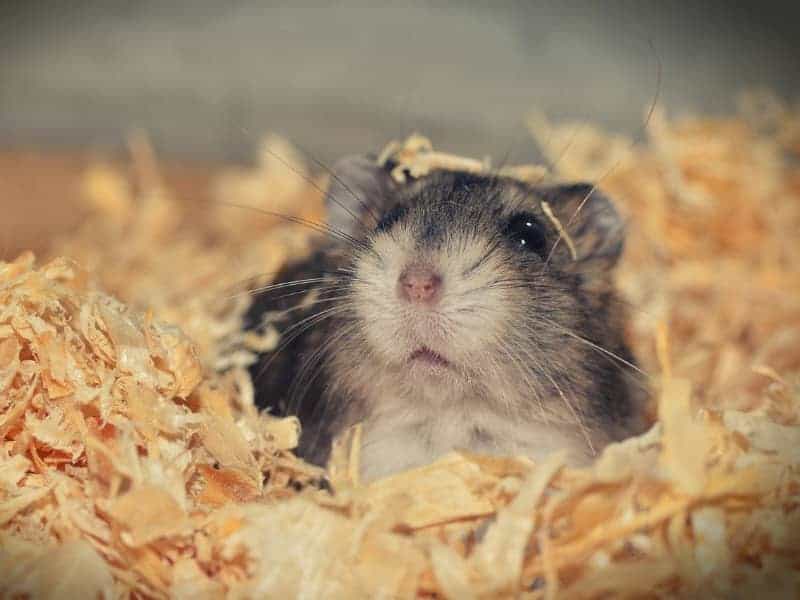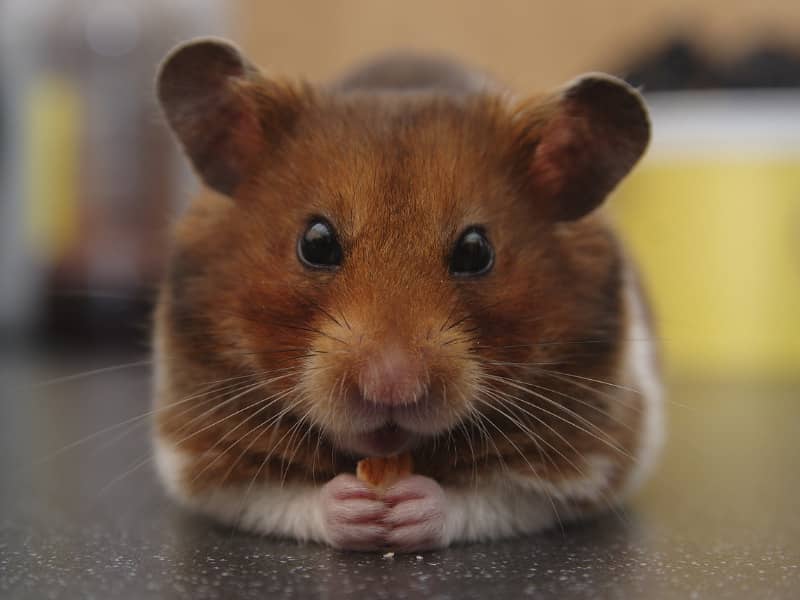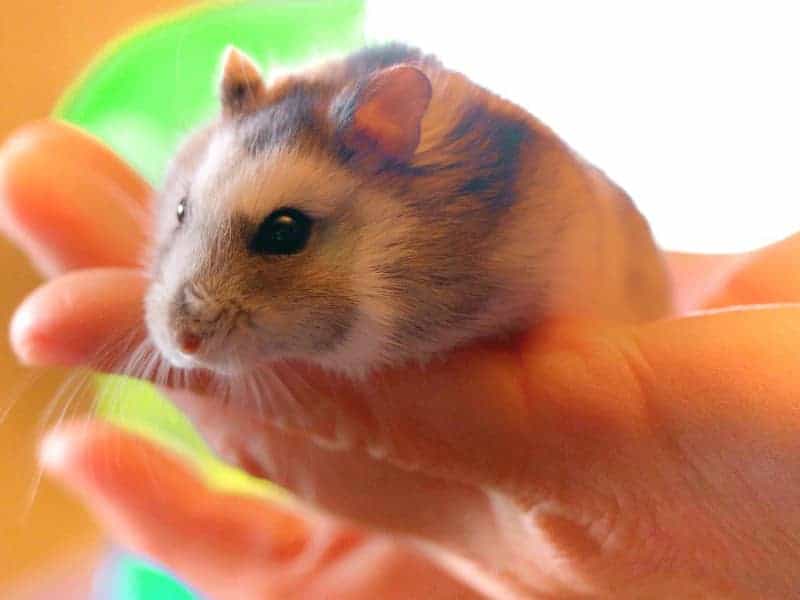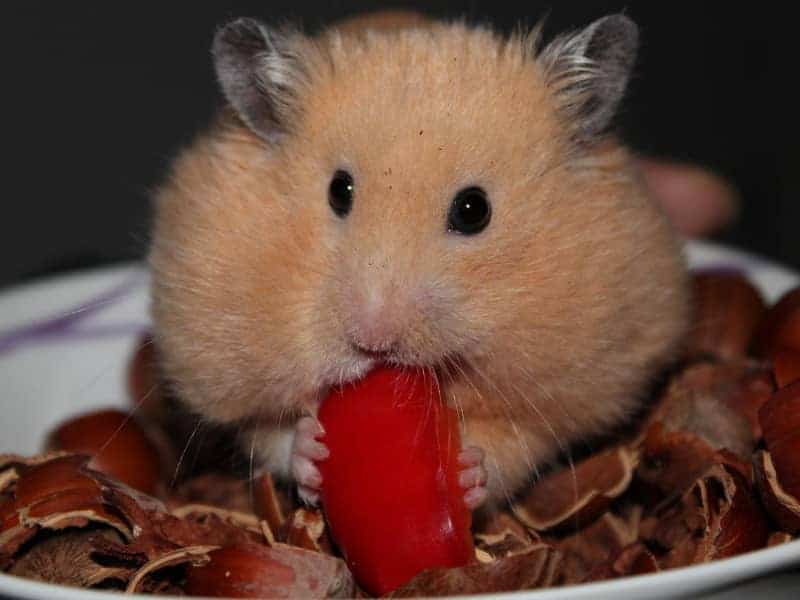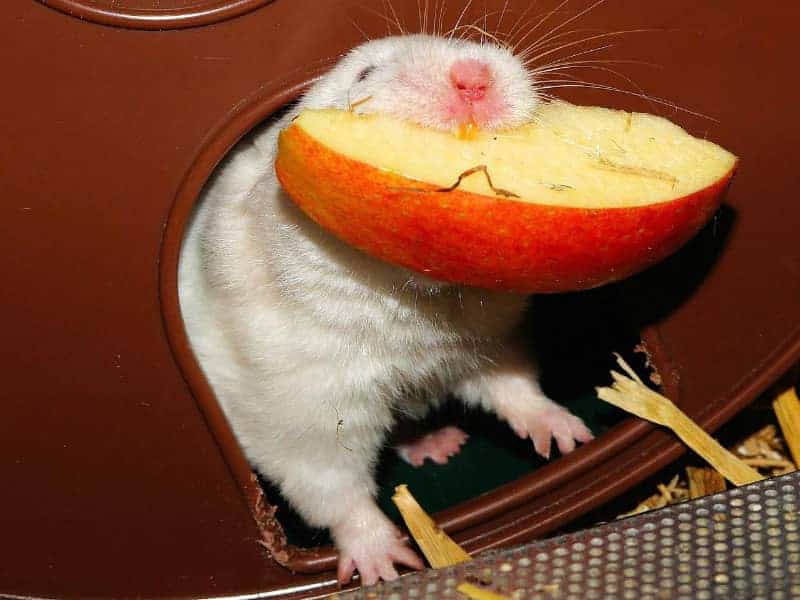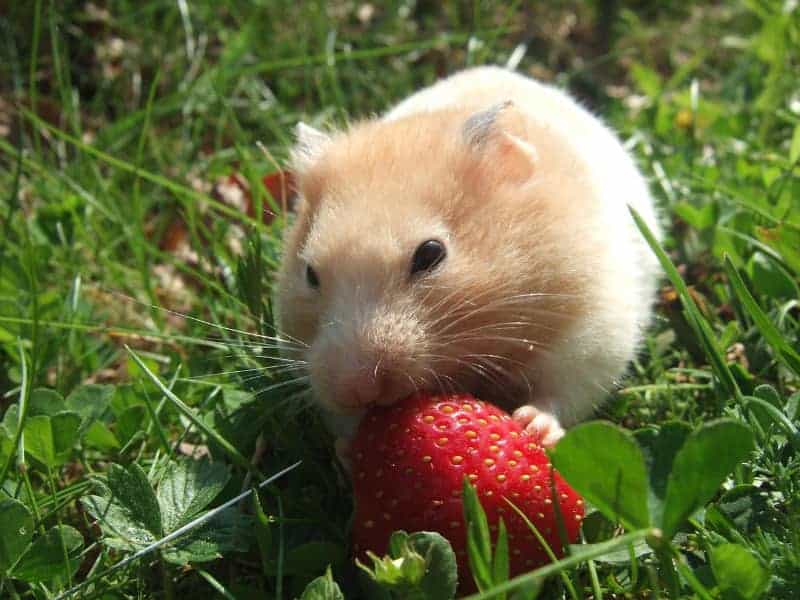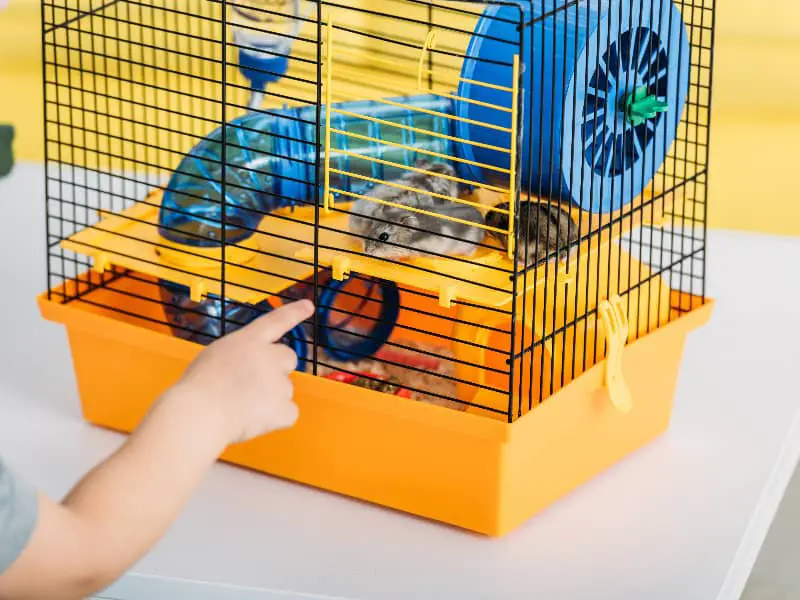
Keep hamster busy
Keeping a hamster sufficiently busy is much more than just a pastime for the animal. It affects both its mental and physical health and helps prevent boredom. But what exactly is the effect of proper occupation? We will go into this in the next sections.
Keeping hamsters busy for mental health
Your hamster is a small but complex creature with needs that go beyond just eating and sleeping. Mental stimulation is essential to avoid depression, stress or anxiety. Balanced activity will keep your hamster active and curious.
In the natural habitat, hamsters are busy foraging for food, protecting themselves from enemies, and building a nest. In the home, these challenges are often lacking, which can lead to under-stimulation of the mind. Therefore, it is important to provide the hamster with new incentives on a regular basis.
Simple activities like walking through tunnels or nibbling on wood can already have a big impact. They challenge the hamster and allow it to actively explore its environment. It can also help to regularly change the arrangement of the cage to provide variety.
However, play with the hamster should always be adapted to his pace and abilities. Too much stress can be counterproductive and should be avoided. A good sign of balanced mental health is when the hamster explores its environment with interest and curiosity, without signs of stress or restlessness.
So a balanced mix of physical and mental activity is important. Training simple commands or tricks can also play a role in this. But more about that later.
Physical health thanks to employment
While mental health plays an important role in your hamster's well-being, physical health should not be neglected, of course. Activity and play will keep your hamster fit and keep his weight in the optimal range. Exercise is an important factor in preventing diseases such as obesity, heart problems or diabetes.
In the wild, hamsters often travel long distances in search of food or to protect themselves from danger. This means that their musculature and cardiovascular system are designed for movement. In a small cage, there is often not enough room for sufficient physical activity. Therefore, it is our task to provide sufficient opportunities for movement.
Running wheels are a popular way to give hamsters a chance to let off steam. However, care should be taken to ensure that the wheel is large enough and has no sharp edges. A wheel that is too small or poorly made can lead to back problems and injury.
Besides running wheels, there are other ways to physically challenge the hamster. For example, climbing frames, ramps or ropes can help strengthen the muscles. Another advantage is that such activities also improve the hamster's coordination and balance.
In any case, care should be taken that the hamster is not overstrained. Especially older animals or animals with health problems need an adapted form of activity. A real way to monitor your hamster's activity level is to observe his behavior and body language. If he withdraws or shows signs of exhaustion, it's time for a break.
So proper physical activity is an indispensable part of keeping your hamster healthy and happy. It is important to cater to the individual needs and abilities of the animal.
Keep hamster busy with own DIY ideas
Who says that keeping your hamster busy has to be expensive? With a few simple DIY ideas, you can provide a varied and exciting environment for your little friend. From cardboard rolls to hidden treats, the possibilities are almost endless. Let's take a closer look at some of these ideas.
Cardboard rolls
Cardboard rolls are a true miracle worker when it comes to keeping your hamster busy. They are inexpensive, easy to obtain, and have numerous uses. You can simply place them in the cage for your hamster to crawl through.
But that's not all. You can also cut small holes in the rolls and fill them with hay or other soft material. This encourages the hamster to live out its nest-building behavior. Another trick: hide small snacks in the roll, which the hamster then has to fumble out. This encourages both mental and physical activity.
However, it is important to make sure that the cardboard rolls are free of adhesives and dyes. An easy way to find suitable rolls is to use empty toilet paper or kitchen paper rolls. These are mostly safe for hamsters as long as they have not come into contact with cleaning products or the like.
There is also the possibility of connecting several cardboard rolls together and thus create a small tunnel or maze complex. There are hardly any limits to your creativity here. The most important thing is that you always watch the hamster carefully to make sure that he does not hurt himself or eat the rolls.
Sand bath
A sand bath is not only a wonderful way to groom your hamster, but it also provides an excellent employment opportunity. All you need is a small bowl and special chinchilla sand, available at pet stores. Avoid ordinary sand or even bird sand, as these are often too fine and can cause breathing problems.
Place the bowl with the sand in the cage and watch your hamster roll around in it and visibly have fun. The sand bath is not only for cleaning, but also for relaxation and can be considered as a kind of "hamster spa".
You can intensify the experience by burying small holes in the sand and encouraging your hamster to dig them out. This encourages his natural instincts and provides a great way to keep him occupied.
Hide treats to keep the hamster busy
Every hamster loves snacks, but it doesn't always have to be easy to get them, right? A great DIY idea is to hide treats in the cage and let your hamster go on a treasure hunt. You can hide the treats under a piece of wood, in a cardboard roll, or even in a small cave.
Hiding snacks encourages your hamster's mental activity and encourages him to explore his cage more intensively. It also mimics the natural behavior of looking for food, and can be very satisfying for your pet.
Please make sure the hidden treats are healthy and suitable for hamsters. Nuts, fruit pieces or special hamster treats are good options. However, avoid foods that contain too much sugar or fat, as these can be harmful to your hamster's health.
Keep hamster busy - buying toys
DIY ideas are fantastic, but sometimes you may want to buy something professional for your little friend. There are a variety of toys and equipment designed specifically for the entertainment and well-being of hamsters. Let's take a look at some of the best options.
Wheels and balls, perfect for keeping hamsters busy
Running wheels are a classic hamster toy and for good reason. They provide a great way for your hamster to exercise and strengthen his muscles at the same time. Be sure to choose an exercise wheel that is large enough to prevent back problems. A diameter of at least 20 cm is recommended for most hamster species.
Hamster balls are another way to give your hamster freedom of movement outside the cage. However, use should be limited in time and under supervision to avoid stress or injury.
Both options have their advantages and disadvantages. Running wheels can stay in the cage and provide a constant opportunity for movement, while balls are an interesting change, but require more supervision.
Tunnels and hiding places
Tunnels and hiding places are not only great hiding places, but also a great opportunity for your hamster to explore its surroundings. They can be made of different materials such as wood, fabric or plastic.
Wooden tunnels have the advantage that they also serve as a nail material. Fabric tunnels are often more flexible and can be made into different shapes. Plastic tunnels are easy to clean, but not suitable for gnawing.
Tunnels and hiding places encourage your hamster's natural behavior of hiding and crawling through tight spaces. They also provide him with a sense of safety and security, which is especially important for shy or fearful hamsters.
Keep hamster busy with climbing toys
Climbing is another natural activity for hamsters and can be encouraged with special climbing toys. Whether ladders, ropes or complex climbing frames - the selection is large. These toys are especially good for improving your hamster's motor skills and coordination.
When choosing, make sure that the material is safe and non-toxic. Wood is usually a good choice, as it additionally serves as a nailing material. However, avoid painted or treated woods as they can be harmful.
Climbing toys provide not only physical challenges, but mental challenges as well, as the hamster must figure out how to get from point A to point B.
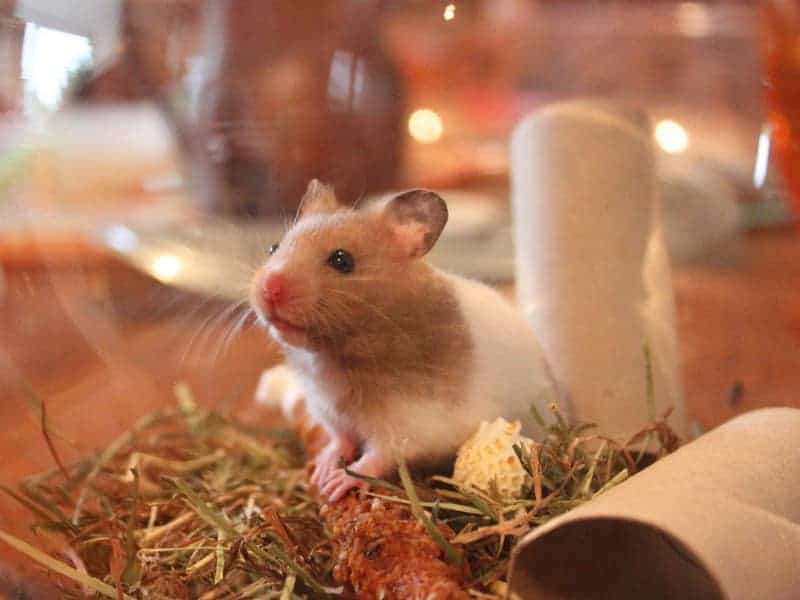
Training and intelligence games for hamsters
Hamsters are much smarter than you often give them credit for. With the right training and some clever games, you can not only boost your little friend's intelligence, but also deepen your relationship. Let's take a closer look at some of these exciting possibilities.
Clicker Training
Clicker training is a great way to teach your hamster simple commands or tricks. The clicker is used as a signal for a desired behavior. As soon as the hamster shows the behavior, you click and reward him with a treat.
This positive reinforcement principle makes it easy for the hamster to learn new skills. It may take a while for him to understand the connection between the clicker and the reward, but with patience and practice you will see success.
Clicker training is not only a great way to keep your hamster busy, but it also fosters a bond between you and your hamster. It creates a communication bridge and makes it easier to teach your hamster new things.
However, it is important to keep the training short and positive. Too long training sessions can be stressful for the hamster. You should also make sure that the treats are healthy and given in moderation.
Puzzle toys
Puzzle toys are a fantastic way to encourage your hamster's intelligence. These toys require the hamster to solve a specific task in order to get a reward. For example, he might have to move a slider or lift a lid.
Such toys are not only entertaining, but also challenging. They encourage your hamster's problem-solving skills and patience. However, make sure the toy is safe and free of small parts that could be swallowed.
"Find the treat"-to keep hamster busy
The "Find the treat" game is a simple but effective way to mentally challenge your hamster. Just hide some treats in the cage and let your hamster search. You can hide the treats under a piece of paper, in a cardboard roll, or in a small cloth bag.
This game not only encourages your hamster's mental activity, but also his sense of smell and natural instincts. It's a great way for him to actively explore his surroundings and get a reward at the same time.
Keep hamsters busy - What you should avoid
Keeping your hamster busy should not only be fun and educational, but most importantly, safe. There are some pitfalls you should avoid at all costs to ensure the well-being of your little friend. Here are some important safety tips to keep in mind.
Unsafe materials
Choosing the right material is critical to your hamster's safety. Avoid toys or equipment that are made of toxic or hazardous materials. A classic example is painted wood, which can contain chemicals that are harmful to hamsters.
Plastic toys can also be problematic if they contain sharp edges or small parts that could easily break off and be swallowed. Before you put a new toy in the cage, you should check it carefully for possible sources of danger.
Also, make sure that any materials you use for DIY projects are safe for your hamster. Untreated wood, cardboard and natural fabrics are usually good options.
Dangerous toys
Not every toy advertised as "hamster friendly" is actually safe. Sometimes toys are poorly made or contain design flaws that can pose a danger to your hamster. One example is exercise wheels with crevices where your hamster's paws can get caught.
Therefore, always make sure to check toys thoroughly or read customer reviews before buying. Regular inspection of the toy for signs of wear or damage is also recommended.
Hamster overload
While employment and play are important for your hamster's health, too much of a good thing can also be harmful. Over-exertion can lead to stress, anxiety and even health problems.
Watch your hamster carefully for signs of stress or overwhelm. These include restless behavior, frantic movements, or avoidance of toys and activities that he normally enjoys.
In such cases, it is best to take a break and give the hamster time to recover. Remember that quality is often more important than quantity when it comes to keeping your hamster busy.
Keep hamsters busy - The role of the environment
Keeping your hamster busy is only one aspect of his well-being. The environment in which he lives plays an equally important role. It can greatly influence your little friend's behavior and activity. Let's take a closer look at some of these influencing factors.
Cage size and furnishings
The size and layout of the cage have a huge impact on your hamster's ability to stay busy. A cage that is too small can harm your hamster not only physically, but also psychologically. It offers little room for movement and exploration, which can lead to boredom and stress.
Make sure the cage has enough space for various activities. This includes running areas, hiding places, climbing opportunities and toys. Different levels can also help to make the most of the space.
The setup should also be changed regularly to provide variety and new challenges. This encourages your hamster's curiosity and desire to explore.
Time of day an important factor in hamster employment
Hamsters are usually nocturnal or crepuscular. This means that they are mainly active in the evening and at night. Adapting your hamster's activity to its natural rhythm can significantly improve its well-being.
Try to schedule play and exercise times during your hamster's active periods. This not only encourages his willingness to be active, but also minimizes the stress that could result from disrupting his natural rhythm.
Social interaction
Although many hamster species are solitary animals, social interaction plays an important role in their lives. This is especially true in their relationship with you, the owner. Regular, positive interactions can strengthen the trust and bond between you and your hamster.
This can be as simple as playing together, hand feeding or gentle petting. However, be sure to respect your hamster's limits and not overtax him.
Some hamster species, such as dwarf hamsters, can also get along well with conspecifics as long as they are properly socialized. In this case, interaction with other hamsters can be an important form of employment.
Conclusion: Keep hamsters busy
Keeping your hamster busy is a multi-faceted issue that goes far beyond simply putting toys down. It's about nurturing both the physical and mental health of your little friend. From DIY ideas to store-bought toys to training and intelligence games, there are numerous ways to provide your hamster with a varied and stimulating life.
But not only the type of activity is crucial, but also the environment in which it takes place. A well-designed cage, consideration of the natural activity phases and social interaction play an equally important role.
Above all, it is important to cater to your hamster's individual needs and abilities. Each hamster is unique and what is enjoyable for one may be overwhelming for another. Through observation and adaptation, you can ensure that your hamster lives a happy and healthy life.
FAQ: Questions about hamster employment
How much activity does my hamster need daily?
The amount of activity needed can vary from hamster to hamster. However, a good guideline is to allow at least 20-30 minutes per day for interactive activity. This is in addition to the activities that the hamster performs independently in the cage.
Can I teach my hamster tricks?
Yes, many hamsters are capable of learning simple tricks or commands. Clicker training is a proven method to teach your hamster new skills.
Are hamster balls safe?
Hamster balls can be a good way to give your hamster more freedom of movement. However, they should only be used under supervision and for short time intervals to avoid stress and overexertion.
What materials should I use for DIY projects?
Untreated wood, cardboard and natural fabrics are usually good options. Avoid painted or chemically treated materials as these can be harmful to the hamster.
My hamster seems to be bored. What can I do?
Boredom in hamsters can be caused by a number of factors. Try varying the employment opportunities and creating new challenges. Changing the cage setup can often work wonders as well.
How do I know my hamster is overwhelmed?
Signs of overexertion may include restlessness, frantic movements, or avoidance of activities that the hamster normally enjoys. In such cases, it is best to take a break and give the hamster time to recover.
Can I keep several hamsters together?
This depends on the hamster species. Some species, like certain dwarf hamsters, can be kept with conspecifics under certain conditions. Others, like the golden hamster, are strict loners.
Can I give my hamster human food as treats?
While some foods, such as certain vegetables, are fine, many human foods should be avoided. Foods high in sugar, salt or fat are not suitable for hamsters.
Are all wheels equally good for my hamster?
No, the quality and size of the wheel can have a significant impact on your hamster's health. A wheel that is too small can cause back problems, while a wheel with gaps or gaps can cause injury.
How can I tell if my hamster is getting enough exercise?
A good way to do this is to observe your hamster's weight and general behavior. An active, curious hamster that is maintaining its weight is probably getting enough exercise.
Can I let my hamster run free in the room?
This is possible, but only under strict supervision and in a safe environment. Make sure there are no exposed electrical wires, poisonous plants or other hazards.
What signs indicate that my hamster is underutilized?
Signs of under-activity may include apathy, increased sleeping, or repetitive behavior such as running in a wheel all the time. In such cases, employment opportunities should be reconsidered and possibly expanded.
How often should I change the toys and cage equipment?
There is no set time frame, but a good rule is to change the setup every few weeks. This keeps the environment interesting and stimulating for your hamster.
Author

-
Garden animal - A life with nature
Welcome to my animal blog! My name is Dirk and I am happy to take you on my journey through the fascinating world of animals and gardening.
Born 54 years ago, I have had an insatiable curiosity for the animal world around me since childhood. Although I have moved professionally in other industries, my true passion has always been animals and nature. It is remarkable how a small garden has become such an important part of my life.
Many of my fondest memories are associated with the animals that share our home. Whether it's the curious squirrels that scurry across the trees in the morning, the colorful variety of birds that visit our feeders, or the busy bees and butterflies that pollinate our flowers, every moment with them is invaluable to me.
This blog is my contribution to share my experiences, discoveries and insights with like-minded people. Here I will share stories of unforgettable encounters with animals, give tips on gardening and creating wildlife-friendly habitats, and take you on my journeys through nature.
Thank you so much for being here!
Cordial,
Dirk aka garden animal
Last posts
- 27. February 2024PetsVeganes Hundefutter – Grün und Gesund?
- 18. January 2024ChickensOregano für Hühner
- November 27, 2023HamsterDiurnal hamsters
- November 24, 2023HamsterHamster hammock

